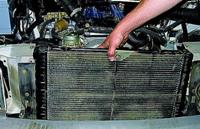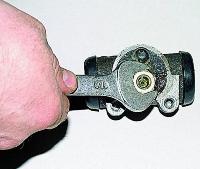Design features of the brake master cylinder
The main brake cylinder, with two pistons 10 and 17 in series and a two-section reservoir 4 with a sensor 6 for an emergency drop in the brake fluid level, is attached to the cover of the vacuum booster
The brake master cylinder pressurizes two independent hydraulic circuits.
The volume of brake fluid between pistons 10 and 17 is used to actuate the rear brakes, and the volume of fluid between piston 17 and the end of plug 20 is used to actuate the front brakes.
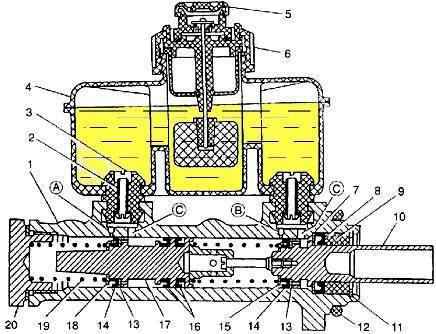
When braking, moving forward, the primary piston 10 and its cuff 15 block the compensation hole "B" connecting the primary cavity of the master cylinder with the reservoir.
The spring installed between the pistons 10 and 17 is stronger than the spring 19 located between the piston 17 and the plug 20, therefore, simultaneously with the primary piston 10, the secondary piston 17 also begins to move, blocking the compensation hole "A" connecting the secondary cavity of the cylinder with the cuff. cistern.
Further movement of the pistons is accompanied by an increase in pressure in the cavities, and, consequently, both brake circuits are activated.
When the force is removed from the brake pedal, the pistons return to their original position under the action of the springs.
At the same time, compensation holes "A" and "B" open and the liquid in both cavities of the main cylinder communicates with the liquid in the tank, while the pressure in the circuits decreases to atmospheric pressure.
If the brake pedal is released abruptly, the master cylinder pistons quickly return to their original position and are ready for subsequent braking.
The quick return of the pistons is ensured by the fact that when they return to their original position, a vacuum is created in the cavities of the master cylinder, under the action of which the liquid from the tank through the bypass holes "C" and the holes in the pistons, squeezing the washers 13 and the edges of the cuffs 14, enters cavity of the master cylinder.
When the pistons reach their original position, excess liquid from each cavity will flow through the compensation holes "A" and "B" into the reservoir.
When one of the drive circuits fails, fluid leaks from the cavity of the main cylinder connected to the faulty circuit.
If the rear circuit is faulty, then the piston 10 reaches the spring holder 16 and through it acts on the secondary piston 17, which creates pressure in the secondary cavity of the master cylinder and the front circuit.
If the front brake circuit fails, piston 17 acts on the end of plug 20, and piston 10, compressing the spring, displaces fluid from the primary cavity of the master cylinder into the circuit going to the rear wheel brakes.
If one of the drive circuits fails, the brake pedal stroke increases, but the vehicle is sufficiently effectively braked.
With good circuits, the brake fluid level in the master cylinder reservoir should be between the MAX and MIN marks.
The gradual change in fluid level from MAX to MIN is due to the wear of the brake linings.
A sharp drop in the level of brake fluid in the reservoir indicates a violation of the tightness of the brake system.
At the same time, the brake fluid level warning light is activated and the red lamp on the instrument cluster lights up.
In this case, add liquid only after the system is sealed.
To check the serviceability of the sensor 6 of the emergency drop in the liquid level in the tank, it is necessary to press the central part of the protective cap 5 from above with the ignition on.
At the same time, the lamp on the instrument cluster should light up.
Brake Master Cylinder Repair
Remove the brake master cylinder. (See the article - Removing and installing the master brake cylinder).

Remove the O-ring.
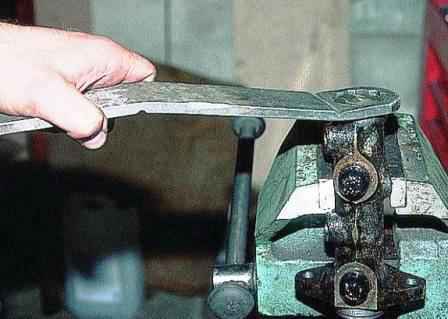
Use a key or a “38” head to unscrew the plug of the master brake cylinder

Remove the cork together with the sealing ring

Retrieve the spring.
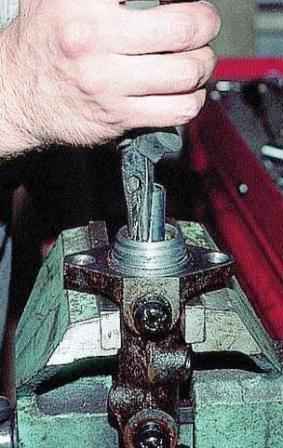
Squeeze the retaining ring with round-nose pliers

Remove it.
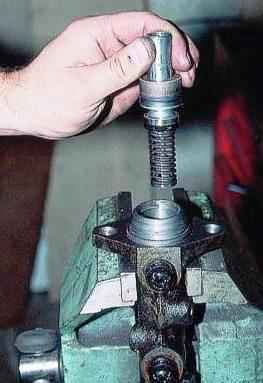
For the shank we take out the piston of the rear contour together with the outer cuff and guide sleeve.
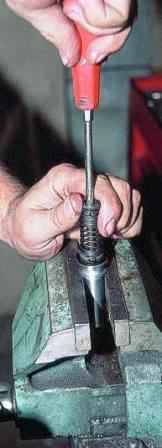
To remove the cuff from it, unscrew the screw of the spring holder.
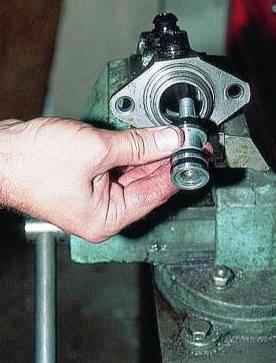
Remove the piston of the front contour by pushing it with your finger from the side of the thread, and remove the separating cuffs by carefully prying them with a thin screwdriver.

Rinse all parts in clean brake fluid or isopropyl alcohol
We assemble the brake master cylinder in reverse order.
We install new cuffs as shown in the figure.
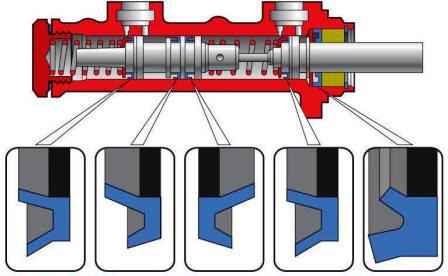
Tighten the screw of the primary piston spring holder to the stop.
WARNING: Do not wash parts of the brake system with gasoline, acetone or other solvents that damage rubber cuffs.
Before installing new parts, wash off the preservation grease from them.
You can flush with alcohol and brake fluid.









